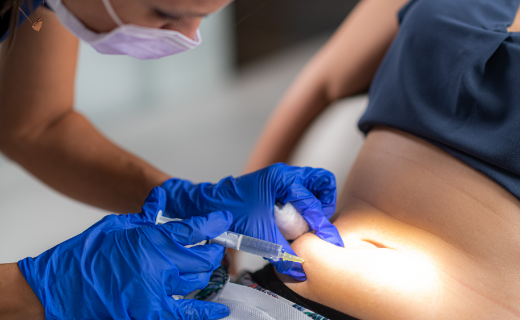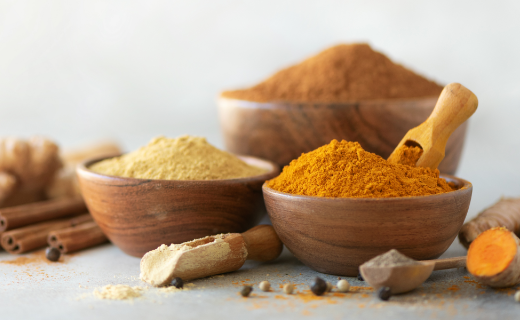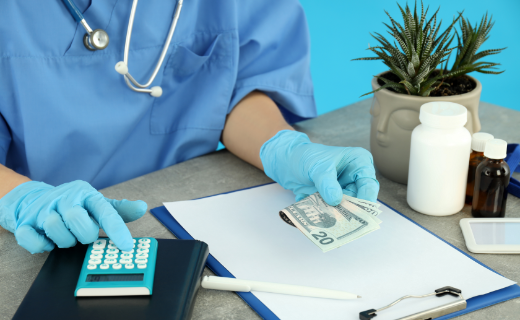
Abnehmen durch Injektionslipolyse?
Die Injektionslipoyse ist eine beliebte Behandlung in der ästhetischen Medizin, welche zur gezielten Beseitigung kleiner bis mittlerer Fettpölsterchen angewandt…

Acne, which is also known as acne vulgaris, is one of the most common skin diseases in dermatology. If left untreated, acne spreads and develops into a chronic inflammatory disease. In this article you will learn what promotes acne and how acne is most effectively treated in terms of ingredients in the skin care routine.
Acne can be caused by multiple factors and mostly appears during puberty. The excess production of sebum as well as the presence of comedones, pustules, and papules is typical. Some patients also develop deep lesions and abscesses that can lead to scarring.
Acne has a large impact on the public health system, as it is among the first three most common skin diseases in the general population (1,2). Although acne is, epidemiologically, a worldwide disease in puberty, it is more common in developed countries.
Severe forms often appear in men, presumably due to the influence of androgens. In adult women it is typically related to discontinuing hormonal contraceptives, e.g. due to the desire to conceive, which statistically happens later and later in the female population of the Western world.
As a multifactorial dermatosis, it can also be caused by an increased production of sebum, inflammatory mediators in the skin, and colonization by a microbe called Propionibacterium acnes (3,4).
In addition, studies have shown the existence of a genetic predisposition. Women whose mothers had acne have a higher probability to develop acne themselves. Furthermore, hormonal dysfunction such as overproduction of androgens, immunological disorders, environmental factors, and the wrong cosmetics can lead to this disease (5).
For many years it has remained controversial if acne can be caused by certain food products. There have been performed lots of studies. On the basis of these findings, it can be said that foods which contain a high glycemic load led to a worsening of acne (6,7).
It has also been discussed that acne could be caused by the consumption of red meat. A recent cross-sectional study conducted among adolescents in Nigeria showed a significantly higher prevalence of acne among students who reported a daily intake of fried beef (8).
In order to be able to make an evidence-based statement on the Western population, further studies need to be conducted.
Regarding protective dietary factors, recent studies show that a diet rich in w-3 polyunsaturated fatty acids leads to a decrease of inflammation in acne lesions (9). Therefore, a diet rich in vegetables and fish is recommended.
Other recommendations to combat the causes of acne include the diagnosis and treatment of associated syndromes such as polycystic ovary syndrome (PCOS). Patients with PCOS classically present with acne as a sign of hyperandrogenism, among other causes.
As recent observations point to higher levels of bisphenol A in biological fluids of women with PCOS and its role in the pathogenesis of hyperandrogenism and hyperinsulinemia (10), it remains unclear if bisphenol A could also play a role in the pathogenesis of acne.
Therapeutic strategies include both topical and systemic treatment of acne. Treatment should be started quickly after diagnosis, in particular, to avoid scarring. An important pillar of the cosmetic treatment of seborrheic skin is the thorough, but gentle cleansing of the skin, because cleansing measures that are too aggressive can cause worsening of the seborrhea.
Well-suited formulations for the care of seborrheic skin are usually oil-in-water emulsions. To prevent acne caused by make-up products (acne cosmetica) in individuals with seborrheic skin, water-in-oil emulsions and ointments should be avoided.
This is why the choice of skin care products is essential. Not only the formulation, but also the ingredients play a crucial role. Here, we present some of the key ingredients that a skin care cosmetic line should include:
In conclusion, the treatment of acneic skin is an integral part of a well-rounded and healthy lifestyle. Proper skin care has an anti-inflammatory and moisturizing effect and is crucial in order to avoid unnecessary irritation.

Abnehmen durch Injektionslipolyse?
Die Injektionslipoyse ist eine beliebte Behandlung in der ästhetischen Medizin, welche zur gezielten Beseitigung kleiner bis mittlerer Fettpölsterchen angewandt…

Antioxidants aid in the prevention of the development of chronic diseases. Common examples include compounds derived specifically from plants…

Ärztliches Honorar in der Ästhetik
Da es sich bei ästhetischen Behandlungen ausschließlich um Privatleistungen handelt, sind diese auch für die behandelnden Ärzte durchaus profitabel. Doch was ver…
1. Bhate K, Williams HC. Epidemiology of acne vulgaris. Br J Dermatol 2013; 168: 474-85.
2. Wolkenstein P, Grob JJ, Bastuji-Garin S, et al. French people and skin diseases: results of a survey using a representative sample. Arch Dermatol 2003; 139: 1614-9.
3. Zouboulis CC. Acne vulgaris. Hautarzt 2014 65: 733–750.
4. Michael Landthaler, Thomas Ruzicka, Walter Burgdorf, Gerd Plewig. Braun Falco’s Dermatology. Springer-Verlag, Berlin, Heidelberg 2011.
5. Jean L. Bolognia , Julie V. Schaffer , Lorenzo Cerronia. Dermatology. 4th Edition. Elsevier.
6. Bowe WP, Joshi SS, Shalita AR. Diet and acne. J Am AcadDermatol 2010; 63: 124-41.
7. Cordain L, Lindeberg S, Hurtado M, et al. Acne vulgaris: a disease of Western civilization. Arch Dermatol 2002; 138: 1584-90.
8. Okoro EO, Ogunbiyi AO, George AO, Subulade MO. Association of diet with acne vulgaris among adolescents in Ibadan, southwest Nigeria.Int J Dermatol. 2016 Sep; 55(9): 982-8.
9. Melnik BC. Linking diet to acne metabolomics, inflammation, and comedogenesis: an update. ClinCosmetInvestigDermatol. 2015 Jul 15; 8: 371-88.
10. Rutkowska A, Rachon D.Bisphenol A (BPA) and its potential role in the pathogenesis of the polycystic ovary syndrome (PCOS).GynecolEndocrinol. 2014 Apr 30;(4):260-5.
11. Abendrot M, Kalinowska-Lis U. Zinc-containing compounds for personal care applications. Int J Cosmet Sci. 2018 Aug; 40 (4): 319-327.
12. Zhao H, Li S, Luo F, Tan Q, Li H, Zhou W. Portulacaoleracea L. aidscalcipotriol in reversing keratinocyte differentiation and skin barrier dysfunction in psoriasist hrough inhibition of the nuclearfactorκBsignalingpathway.ExpTher Med. 2015 Feb 9(2): 303-310.
13. Hettwer S, Bänziger S, Suter B, Obermayer B.Grifolin derivatives fromAlbatrellusovinusas TRPV1 receptorblockersforcosmeticapplications.Int J CosmetSci. 2017 Aug 39(4): 379-385.
14. Proksch E, de Bony R, Trapp S, Boudon S.Topicaluseofdexpanthenol: a 70th anniversaryarticle.J DermatologTreat. 2017 Dec 28 (8): 766-773.


Erfahre als Erster von Neuigkeiten in der ästhetischen Medizin und profitiere von exklusiven Angeboten sowie Tipps von unseren erfahrenen Dozenten.

We will call you back soon